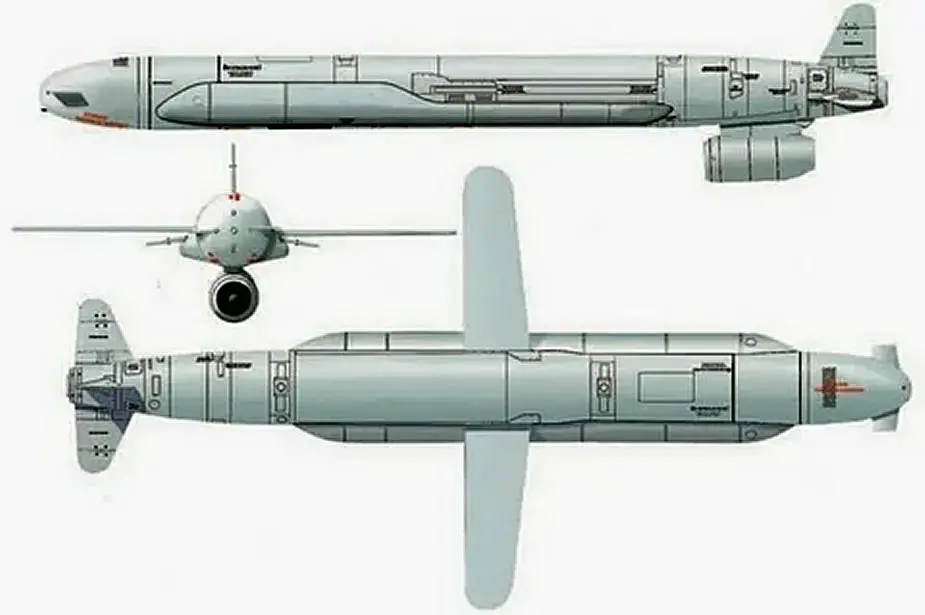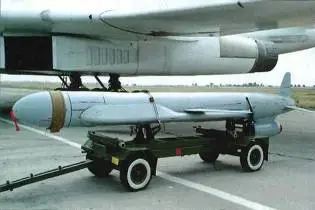- Army
- Air Defense Systems
- Anti-tank systems and vehicles
- Armored Vehicles
- Armoured personnel carriers
- Artillery Vehicles and Weapons
- Command Post
- Communication Vehicles and Systems
- Electronic Warfare
- Engineer | Maintenance Vehicles
- Infantry Fighting Vehicles
- Main Battle Tanks
- Missiles
- Tactical and Logistic Vehicles
- Radars
- Unmanned Systems
- Weapons
- Navy
- Air
Kh-555
Kh-555
Air-launched subsonic cruise missile - Russia

Description
The Kh-555 is a Russian long-range, subsonic cruise missile with a conventional or nuclear warhead, and its history can be traced back to the development of the Kh-55 in the late 1970s and early 1980s. The Kh-55, also known as the AS-15 'Kent', was designed by the Soviet Union's Raduga Design Bureau as an air-launched weapon for strategic bombers like the Tupolev Tu-95MS and Tu-160. The missile entered service in the early 2000s and has since become an important component of Russia's airborne strategic force.
The Kh-555 is an upgraded version of the original Kh-55, featuring various improvements such as a more advanced guidance system, an extended range, and a reduced radar cross-section. The primary motivation behind the development of the Kh-555 was to provide the Russian military with a more capable and sophisticated cruise missile for use in strategic and tactical scenarios.
The Kh-555 entered service in the early 2000s and has since become a significant component of Russia's airborne strategic force. Its versatility and long-range capabilities make it a formidable weapon, able to engage a wide range of targets, including enemy infrastructure, military installations, and naval assets.
The Kh-555 is a highly advanced cruise missile developed by Russia as an upgrade to the earlier Kh-55. It offers improved range, accuracy, and stealth capabilities, making it a crucial part of Russia's strategic and tactical arsenal.
On April 28, 2023, followed by another attack on May 1, 2023, the Russian armed forces carried out extensive assaults on urban areas in Ukraine, employing Kh-101 and Kh-555 air-launched cruise missiles. These missiles have a history of being used in Syria to instill fear and are launched from Tu-95 and Tu-160 strategic bombers.
Kh-555 cruise missile variants:
- No variants at this time.
Technical Data
| Design |
|
The airframe of the Kh-555 cruise missile consists of a cylindrical body with a pointed nose, folding wings, and tail fins. This design aims to minimize the radar cross-section, making the missile more difficult to detect and track. The folding wings and tail fins allow for efficient storage within the limited space of the strategic bombers from which it is launched, such as the Tupolev Tu-95MS and Tu-160. The design and layout of the Kh-555 focus on range, accuracy, and stealth capabilities, making it a formidable weapon in Russia's strategic and tactical arsenal.
|
| Warhead |
|
The Kh-555 cruise missile is designed to carry either a conventional or nuclear warhead, depending on the mission requirements and the intended target. This versatility allows the missile to engage a wide range of targets, including enemy infrastructure, military installations, and naval assets.
In the case of a conventional warhead, the Kh-555 is typically equipped with a high-explosive fragmentation payload. The weight of this conventional warhead can be around 400 kg (880 lbs). This type of warhead is designed to inflict significant damage upon impact, as the high-explosive charge releases a lethal blast and fragmentation effect over a broad area. When it comes to nuclear warheads, the Kh-555 can be armed with a smaller, yet highly destructive payload. The missile's nuclear warhead usually has a yield in the range of 200 kilotons. This makes it a powerful weapon capable of causing immense destruction in the event of a nuclear conflict. The choice of warhead depends on the strategic objectives of the mission and the nature of the target. The ability to carry both conventional and nuclear warheads adds to the Kh-555's versatility and its importance within Russia's airborne strategic force. |
| Propulsion |
| The Kh-555 cruise missile employs a turbofan engine for its propulsion system. This type of engine is known for its fuel efficiency and ability to maintain a subsonic cruising speed, which is well-suited for long-range strategic operations.
A turbofan engine works by using a combination of a gas turbine engine and a ducted fan. The engine ingests air through an inlet, and a portion of the air is compressed and mixed with fuel, which then combusts in the combustion chamber. The hot gases produced are expelled through the turbine section, generating thrust. The remaining bypassed air is accelerated through the ducted fan, which also contributes to the thrust generated by the engine. This process provides a balance between thrust and fuel consumption, allowing the Kh-555 to travel long distances while maintaining its subsonic speed. The turbofan engine's efficiency and performance characteristics make it a suitable choice for the Kh-555 missile, providing the necessary range and speed to effectively engage targets at great distances. The engine's lower noise and heat signature compared to other propulsion systems also contribute to the missile's stealth capabilities, making it harder for adversaries to detect and intercept. |
| Guidance Systems |
| The guidance system of the Kh-555 cruise missile is an advanced and sophisticated assembly of various technologies that enable the missile to navigate accurately over long distances and engage its targets with high precision. The missile primarily relies on an Inertial Navigation System (INS), which is a self-contained system that calculates the missile's position, velocity, and orientation using accelerometers and gyroscopes. The INS allows the Kh-555 to navigate autonomously without the need for external reference points.
In addition to the INS, the Kh-555 also employs satellite-based navigation systems, such as the Russian GLONASS or the American GPS. These systems provide continuous updates on the missile's position and help to further refine its course, ensuring even greater accuracy during the flight. Another essential component of the guidance system is the terrain contour matching (TERCOM) technology. This feature compares the stored terrain data with the actual terrain the missile is flying over, enabling the missile to maintain a low altitude and stay below enemy radar coverage. |
| Combat Use |
| The Kh-555 cruise missile is designed for combat use in strategic and tactical scenarios, with its primary role being the engagement of various high-value targets. These targets can include enemy infrastructure, command and control centers, military installations, air defense systems, and naval assets.
The missile has a range of approximately 3,000 km (1,864 miles), enabling it to strike targets deep within enemy territory. Its long range is one of the critical features that make it suitable for use in strategic operations. The Kh-555 is launched from strategic bombers such as the Tupolev Tu-95MS and Tu-160, which further enhances its operational reach. In terms of altitude, the Kh-555 is designed to fly at low altitudes during most of its flight, typically around 30-50 meters (100-165 feet) above the ground. This low-altitude flight profile helps the missile evade enemy radar detection and air defenses by utilizing the terrain as cover. The missile's terrain contour matching (TERCOM) guidance system plays a crucial role in maintaining this low altitude while navigating accurately. During the final stages of its flight, the missile may descend to even lower altitudes to minimize the chances of detection before reaching its target. The terminal guidance system enables the Kh-555 to home in on its target with pinpoint precision, ensuring high effectiveness in combat. The Kh-555 cruise missile is a versatile and potent weapon designed for long-range engagements against high-value targets. Its range, low-altitude flight profile, and advanced guidance system make it a formidable weapon in Russia's strategic and tactical arsenal. |
Specifications
| Type | Range |
| Air-Launched cruise missile | 2,000 to 2,500 km |
| Country users | Missile Launch Weight |
| Russia | 1,280 kg |
| Designer Country | Speed |
| Russia | 830 km/h |
| Type of Warheads | Altitude Launch |
| Conventional or nuclear warhead, 200 to 410 kg | 60 to 10,000 meters. |
| Accuracy | Dimensions |
| 20 meters | Length: 6.04 m; Diameter: 0.51 m; Wing Span: 3.1 m |
Details View
 |
|
 |
 |
Pictures - Video


























